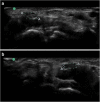Iatrogenic carpal tunnel syndrome induced by wrist extension for placement of an indwelling radial artery catheter: a case report
- PMID: 29457095
- PMCID: PMC5804647
- DOI: 10.1186/s40981-017-0120-7
Iatrogenic carpal tunnel syndrome induced by wrist extension for placement of an indwelling radial artery catheter: a case report
Abstract
A 38-year-old man with pancreatic cancer was scheduled to undergo pancreaticoduodenectomy. He had an unremarkable past medical history. After inducing general anesthesia, a left radial arterial catheter was successfully placed at first attempt. A wrist splint was used to obtain good arterial pulse waveforms. After the operation, he was transferred to the intensive care unit. The radial artery catheter was removed on the fourth postoperative day. He experienced numbness and a tingling sensation in the left thumb, the second and third fingers, and the lateral half of the fourth finger. He was diagnosed with carpal tunnel syndrome. Diagnostic imaging revealed a swollen median nerve, but no hematoma or injury. Some studies have suggested that excessive extension of the wrist may cause neuropathy. We recommend that patients' wrists not be over-extended, even if good arterial waveforms cannot be obtained.
Keywords: Carpal tunnel syndrome; Complication; Radial artery catheter.
Conflict of interest statement
Written informed consent was obtained for publication of this case report.The authors declare that they have no competing interests.Springer Nature remains neutral with regard to jurisdictional claims in published maps and institutional affiliations.
Figures


Similar articles
-
Transverse Ultrasound Assessment of the Displacement of the Median Nerve in the Carpal Tunnel during Wrist and Finger Motion in Healthy Volunteers.J Nippon Med Sch. 2015;82(4):170-9. doi: 10.1272/jnms.82.170. J Nippon Med Sch. 2015. PMID: 26328793
-
An unexpected side effect: Wartenberg syndrome related to the use of splint during carpal tunnel syndrome treatment.Turk J Phys Med Rehabil. 2017 Jun 19;64(1):83-86. doi: 10.5606/tftrd.2018.1186. eCollection 2018 Mar. Turk J Phys Med Rehabil. 2017. PMID: 31453494 Free PMC article.
-
Median Nerve Neuropathy Caused by Persistent Median Artery Thrombosis.Plast Reconstr Surg Glob Open. 2023 Apr 10;11(4):e4916. doi: 10.1097/GOX.0000000000004916. eCollection 2023 Apr. Plast Reconstr Surg Glob Open. 2023. PMID: 37359247 Free PMC article.
-
The numb arm and hand.Am Fam Physician. 1995 Jan;51(1):103-16. Am Fam Physician. 1995. PMID: 7810463 Review.
-
Prevalence of carpal tunnel syndrome in pregnant women.WMJ. 2009 Jul;108(4):194-6. WMJ. 2009. PMID: 19753825 Review.
Cited by
-
Prevention and management of complications associated with arterial catheters.BJA Educ. 2025 May;25(5):173-180. doi: 10.1016/j.bjae.2024.12.003. Epub 2025 Feb 25. BJA Educ. 2025. PMID: 40256655 Review. No abstract available.
References
-
- Wallach SG. Cannulation injury of the radial artery: diagnosis and treatment algorithm. Am J Crit Care. 2004;13:315–319. - PubMed
LinkOut - more resources
Full Text Sources
Other Literature Sources
Miscellaneous
